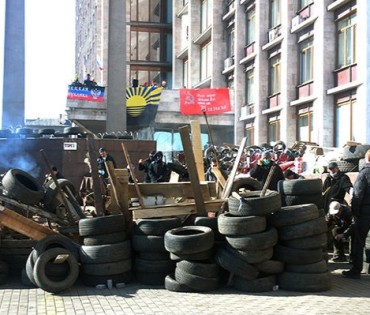Deputy Director of the IWP Kateryna Zarembo for EuobserverIt does seem that Ukraine is long away from stability. The unrest which have been stirred up in the East and the South since Yanukovych’s escape and the formation of the interim government assumed a radical form last weekend. Local government buidlings were attacked and occupied in Donetsk, Luhansk and Kharkiv. Radical groups have proclaimed the Kharkiv and Donetsk «Independent Republics». One of their key demands is holding a referendum on the issue of accession to the Russian Federation, following the Crimean scenario.\
There is much evidence that these protests have hardly anything to do with democracy and popular will, but are rather carefully instigated from the outside.
Indeed, there are no obvious reasons that could bring people to the streets in the East and South of Ukraine. No steps have been taken by the interim government which could anyhow oppress the rights and freedoms of Ukraine’s citizens there. The Verkhovna Rada is exactly the same which was elected in 2012, meaning that the East and the South still have their legitimate representatives there, and the Party of the Regions still has the largest faction in the Parliament.
If the people were unhappy with the former opposition coming to power and forming the interim government, it is strange that the protests only took place now and not in end February. Even stranger is the fact that the protesters do not request the restoration of Viktor Yanukovych in power. In 2010 he won in Donetsk and Luhansk regions with the landslide of 90,44% and 88,96% of votes respectively, and even during the Euromaidan his support in the East and the South was significant. The radicalists don’t even claim the right to run in the upcoming presidential elections for Yanukovych – instead, they demand their cancellation altogether, which conspicuously coincides with Russia’s vision.
Besides, the protesters number is indeed meagre (up to 1000, which is a triffle for Donetsk and Kharkiv with over a million citizens in each), which can hardly lay a claim for a ‘popular’ uprising. Meanwhile, they are equipped with genuine weapons, whereas the multithousand protesters in Kyiv Maidan could only afford sticks and self-made Molotov cocktails.
The small numbers of protesters are explicable by the fact that traditionally the protest potential in the East and in the South is the weakest among all Ukraine’s regions. Even if one imagines that the active minority has decided to take to the streets, it still does not represent the popular will. Independent Donbas Miners Trade Union leader Mykola Volynko stated that Donetsk region miners did not support the separatists. According to the latest Ilko Kucheriv Democratic Initiatives Foundation opinion poll, only 26% of the population in the East and 19% in the South would like to join Russia.
The latest Rating Group poll also indicated that 64% of the Ukrainians are against federalization of the Ukrainian state. This is true for the South and the East alike: according to the poll results, 45% and 44% respectively support the unitary form of the Ukrainian state, while only 22% and 26% are in favour of the federalization.
Hence, it is evident that the South-Eastern crisis is the Russian attempt to destabilise Ukraine at the very least, keep it within its orbit of influence or even restore the former empire.
Skillful resolution of the crisis is now the biggest challenge for the interim government, a real test for their capacity to stand up for and defend Ukraine’s independence. Ukraine knows to its own cost that winning a revolution is not the end of it, defending the results is most important. The 1990 ‘revolution on granite’ and the 2004 Orange revolution were bitter lessons. It remains to be seen whether at the third attempt Ukrainians will finally make it, bearing in mind that their enemy is the most powerful person on the Earth.




Comments theme
Comments themeComments themeComments themeComments themeComments themeComments themeComments themeComments themeComments themeComments themeComments themeComments themeComments themeComments themeComments themeComments themeComments themeComments themeComments themeComments.